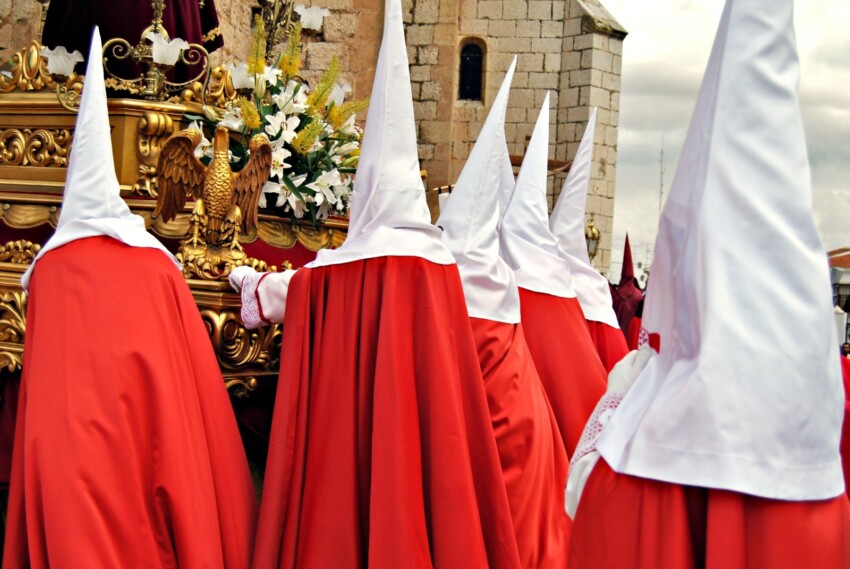

Watchword: ¡fiesta! Fun is in the DNA of the Spanish, a cheerful and sociable people who love life and want to live it with joy. They are also a people deeply attached to their roots, who live their local traditions with passion and enthusiasm. Love of life and their culture are the seeds that have sprouted an incredible number of festivals throughout Spain.
Spanish fiestas are unmissable, an explosion of colour and music with an overwhelming impact. It is difficult, practically impossible, to remain a passive spectator: you will start by taking pictures of the beautiful traditional costumes worn by women, men and children and end up dancing and singing in the company of complete strangers.
From big cities like Madrid and Barcelona to the smallest rural villages, every town in Spain has its own, typical festival(s). Many of these have a religious origin and involve solemn masses and processions that are recommended to attend to experience the tradition in its authenticity. There will then be time for the festivities, which will last so long that they will test your capacity for endurance.
At least once in your life it is good to do as the Spaniards do: let go of inhibitions, sing at the top of your lungs, be friends with everyone and laugh out loud. No matter what time of year you want to go on holiday, you will have no trouble finding a party to attend, but if you want the most fun, choose from the 10 must-see parties in Spain presented below.
For these and other popular festivals in Spain such as the Mercé in Barcelona, the Carnival of Tenerife, the Semana Grande in Bilbao, the Romería del Rocio and the Descenso del Sella, you will need to book flights and hotels well in advance to avoid the risk of finding the festival sold out. That said, all you need is the desire to enjoy yourself to have a unique experience.
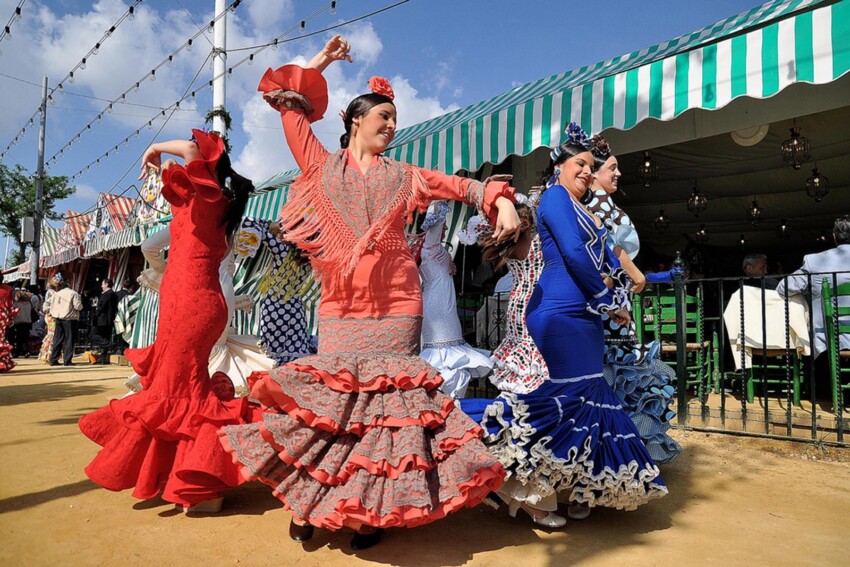
Originating in the 19th century as a livestock fair, Seville‘s Feria de Abril is now Spain’s most famous traditional fiesta and the one that sums up all the typical elements of Spanish culture: unbridled merriment, copious amounts of food and alcohol (in this case rebujito, a cocktail of manzanilla wine and gazosa), music until late at night, dancing in the streets and colourful traditional costumes.
Seeing women and girls parading down the street in magnificent flamenco costumes is already a sight worth the money spent on the plane, but it is highly unlikely that you will just watch: the party atmosphere is contagious and before long you too will be involved in drinking and dancing.
The festival generally takes place two weeks after Easter and lasts for a whole week, during which Seville lives for this event alone.
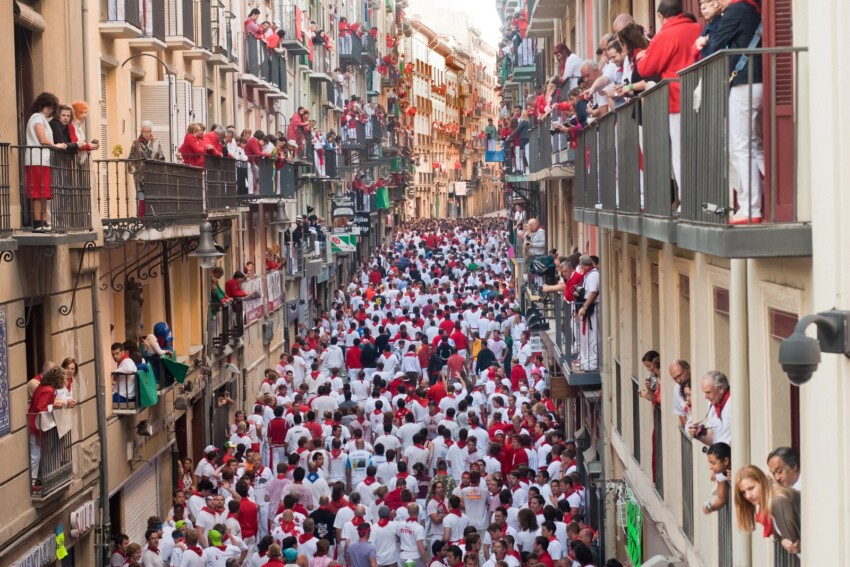
Spain’s most adrenaline-fuelled fiesta is the San Fermin festival in Pamplona (Sanfermines). This is a traditional festival in honour of San Fermin, the city’s patron saint, which lasts from 6 to 14 July with numerous events; internationally it is known for only one of these events, the extremely risky running of the bulls (encierro).
The daredevils who engage in this feat must run a 900-metre route through the streets of the city chased by free-roaming bulls. Those who don’t like danger can watch this delirious spectacle in complete safety from the top of balconies or behind barriers. You won’t necessarily be able to see much because the crowds are overflowing, but you’ll only need a little to get an idea of the risks the runners run. Unfortunately, in some cases, mostly the fault of clueless tourists who joined in with the locals thinking they were taking part in a merrymaking, the party ended in tragedy.
When all the runners are safe, and the bulls unfortunately killed or locked up in pens, the fiesta continues with less bloodshed and more fun to the sound of singing, dancing, wine and much merriment, just like in any other Spanish fiesta.
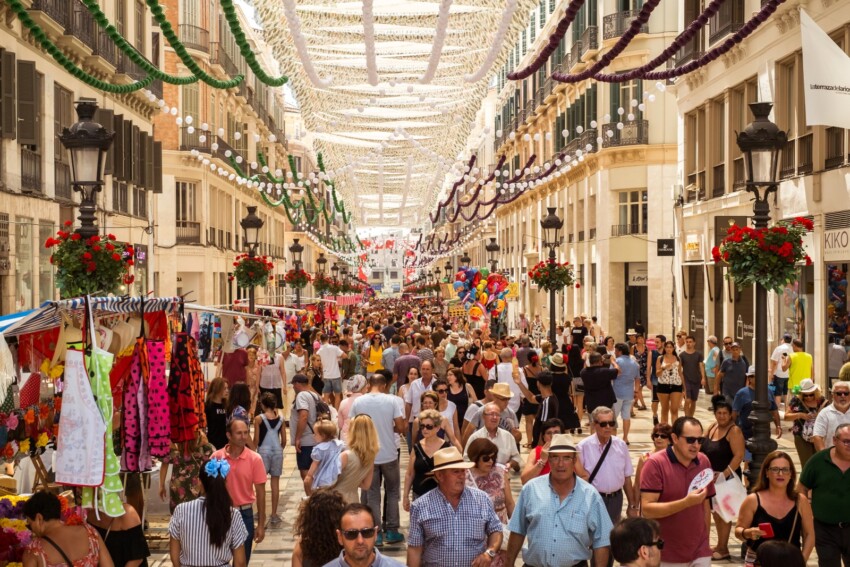
If you can’t take a holiday after Easter but want to attend a typical Andalusian festival, the date for you is August, when another of Spain’s most famous traditional festivals takes place: the Feria de Malaga. Also known as the Feria de Agosto, it is the most important summer festival in Andalusia. It lasts ten days and always ends on a Sunday.
The programme is very rich and includes all sorts of events, suitable for people of all ages: a fair with stalls, modern music concerts, traditional songs, fireworks, religious ceremonies, official communal events, and light shows. Among the events not to be missed are the verdiales, a festival of popular music and dance in which men sing and play and women dance, all dressed in traditional clothes.
During the day, the events take place in the historic centre, while from the evening and late into the night the party moves to the Cortijo de Torres.
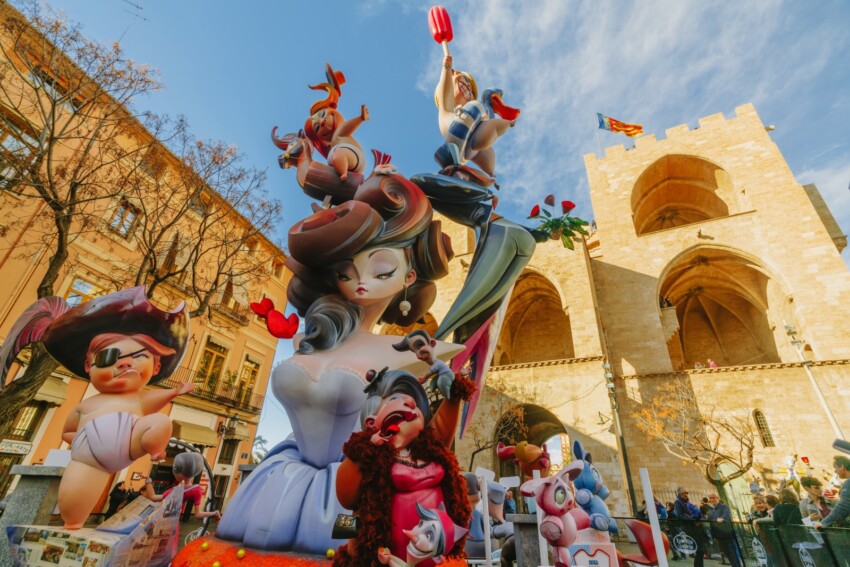
Spain’s most explosive festival is undoubtedly Las Fallas de San José , commonly referred to as Las Fallas, which culminates with a bonfire of enormous papier-mâché and wooden puppets depicting famous or fictional characters in a satirical key.
The festival begins at the end of February, when the gigantic puppets – the result of about a year’s work by groups of enthusiasts – are installed in the streets of the city and left on display until 19 March, when they are set ablaze in a crackling atmosphere of firecrackers, lights and music.
It is a celebration of epic proportions, at first glance even frightening because of the amount of fireworks and noise. The Valencians are used to it and find it exciting: it is an absolute must for them. You, too, will quickly adapt to the collective madness and have one of the most shocking and exciting experiences of your life.
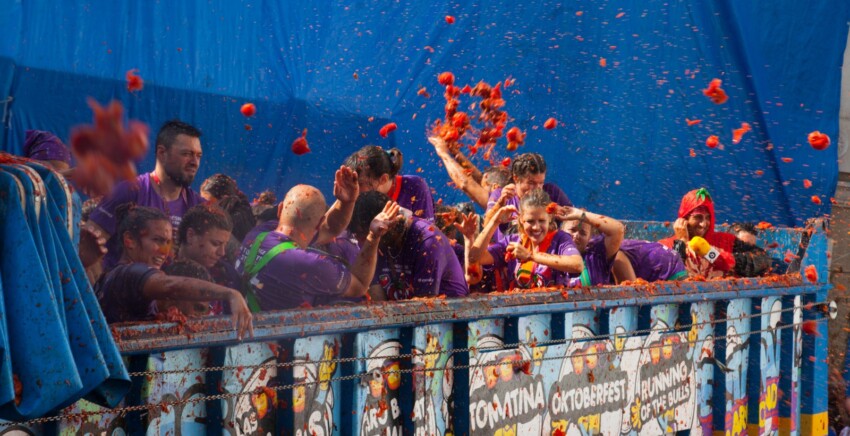
More harmless than San Fermin and Las Fallas is the Tomatina, another Spanish festival that has become an international tourist attraction. Here the danger is tomatoes that people throw at each other: they always stain, but rarely hurt.
The tomato throwing is held during the morning of the last Wednesday in August in Buñol, a town about 40 km from Valencia that has become famous thanks to this festival. The throwing lasts only one hour, enough time to completely colour the streets of the town and the participants’ clothes red, but the party continues with after parties, dinners and other side events.
The origin of the party was a brawl that took place in 1945, but today the atmosphere is one of pure fun: the throwing of the tomatoes becomes a liberating act that unleashes unbridled enthusiasm and joy. Over the years the number of participants in the Tomatina has grown so much that for security reasons it has become necessary to restrict access by requiring the purchase of an entrance ticket.
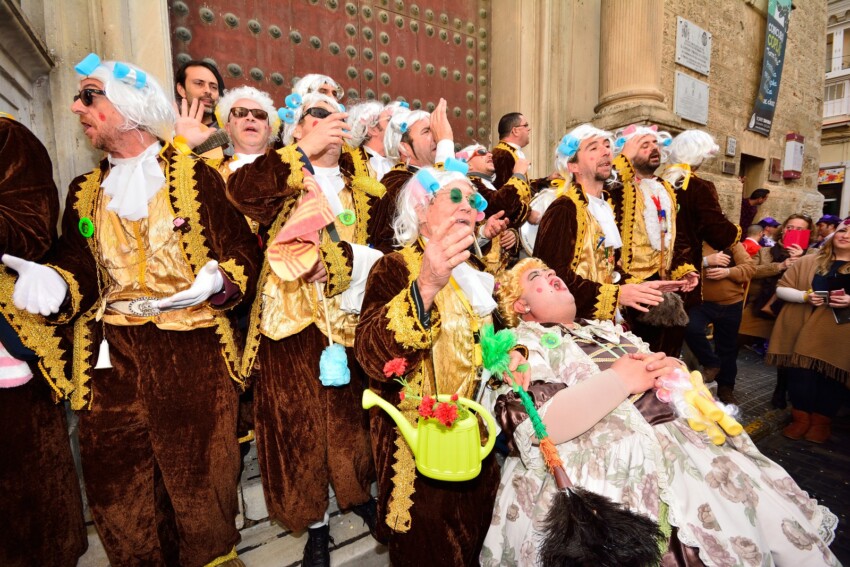
In a country with a party character like Spain, the Carnival tradition becomes another occasion for unbridled fun. Of the many carnivals that are celebrated throughout Spain (including the islands), the most famous is that of Cadiz, eleven days of non-stop partying during which the height of excess is reached.
Forget the romantic atmospheres and elegant masks of the Venice Carnival: the Carnival of Cadiz is all about euphoria, singing and drinking. Disguise is a must, for both adults and children, at least during the two main parades on the programme (but it is always recommended): the Big Parade, with which the festivities open, and the Parade of Humour, which takes place during the final weekend.
More than the official shows and concerts, what entertains the public are the spontaneous performances of the ‘charangas ilegales’: groups of friends, family members or colleagues who perform wild singing performances… it may not be real art, but the good humour is guaranteed.
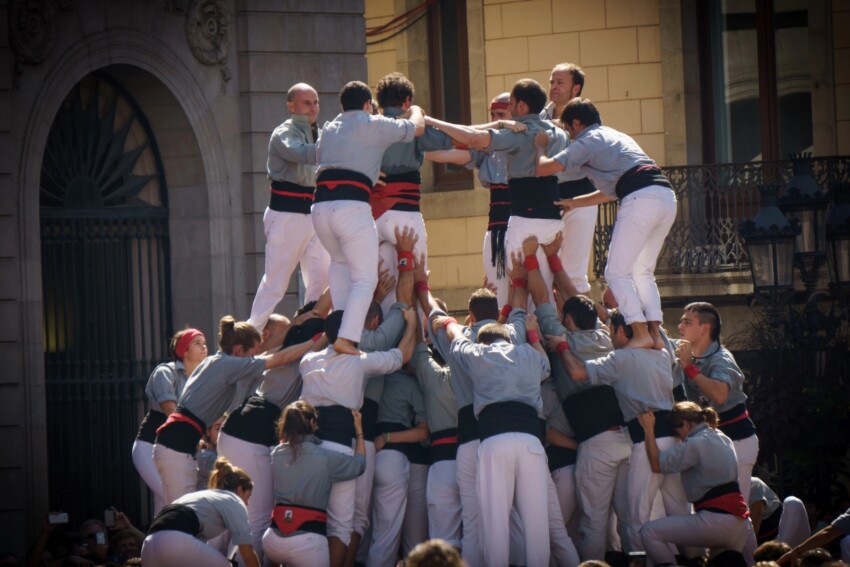
Among the numerous fiestas held in Barcelona, all of which are very popular and experienced with enthusiasm and participation by the citizens, there is one that is less known to the international public but which represents a unique opportunity to experience the city as a local: it is the Festa Major in Gracia, a neighbourhood very close to the centre that has nevertheless retained a warm village atmosphere.
The festival starts on 15 August and lasts for a week, during which the neighbourhood is invaded by stalls and outdoor tables and adorned with elaborate decorations. Tables and decorations are prepared with great care because a competition is held every year to award prizes for the most beautiful ones.
The festival programme includes concerts, shows and popular traditions. You will be able to watch the adrenaline-fuelled competition of the castellers, the human pyramids typical of Catalonia, and the final parade of the Correfocs, the fire-breathing devils.
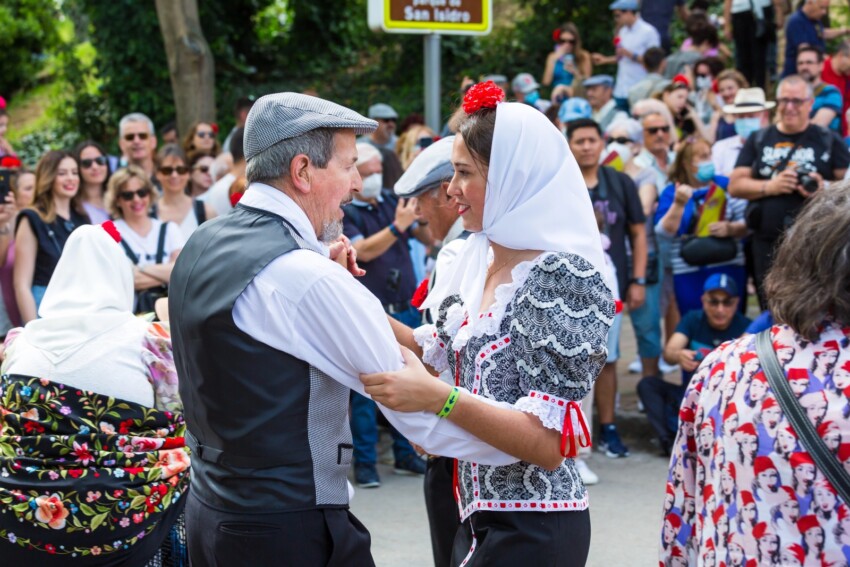
Madrid also loves traditional festivities. The fiesta par excellence in the capital is held on 15 May and is dedicated to San Isidro, the patron saint of the city.
For the occasion, men and women pull out their chulapos, or traditional costumes, from their wardrobes: black suits with white shirts for men, colourful flamenco-style dresses for women. Shawls and flowers are indispensable accessories, especially the red carnation: it is the symbolic flower of San Isidro, worn coquettishly by the women and proudly by the men.
The main event is at the Pradera de San Isidro, but celebrations take place throughout the city to the sound of music, dancing and the inevitable drinking.
If the idea of being able to stain your clothes without feeling guilty appeals to you, there is another Spanish festival that suits you besides the Tomatina: the Festa del Vino in Haro, a town in the region of La Rioja, one of Spain’s most important wine-growing areas.
Also known as the Battle of the Wine, it is another occasion when the streets of the town are filled with people throwing something red at each other: in this case, however, instead of tomatoes, there is wine.
You don’t need tickets or special knowledge to participate: dress in white with a red scarf, as tradition dictates, and arm yourself with plenty of wine and weapons to shoot it at other participants, such as buckets or water pistols. Surrender to the collective madness and spray everyone in your path with wine. Show no mercy as others will do the same to you.
Unlike the Tomatina, which is little more than 50 years old, the Wine Festival is a popular tradition with very ancient origins. Before the drinking battle, citizens go to the Sanctuary of Mount Bilbo to attend a mass; after the battle, they have a snail lunch and continue celebrating – drinking wine, of course – until late in the evening.
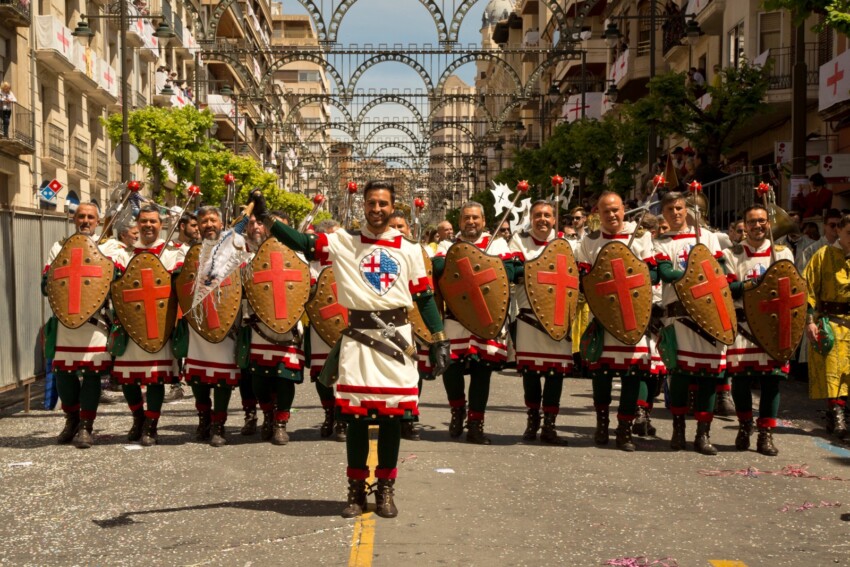
In the panorama of Spanish fiestas, the Fiestas de Moros y Cristianos, a series of fiestas that privilege the solemn aspect over the playful one, stand out clearly from the others. These are historical re-enactments that stage crucial episodes of the final struggle in the Reconquista of the Peninsula by the Christians.
These festivals are held in several locations, but are most popular in the Alicante area. The most famous is the Fiesta de Moros y Cristianos in Alcoy, a town located in a depression at the foot of a mountain. In this evocative natural setting, an event full of magic and shrouded in legend takes place. You will be captivated by the costumes created with great attention to detail, the cleverly staged bloody battles and the grandeur that pervades this event.
The festival begins with the entry of the two armies into the city and the parade through the streets of the centre. This is followed by a religious ceremony, which is the most solemn moment of the event, the reading of a proclamation inviting (unsuccessfully) the two armies to peace, and the long-awaited final battle.